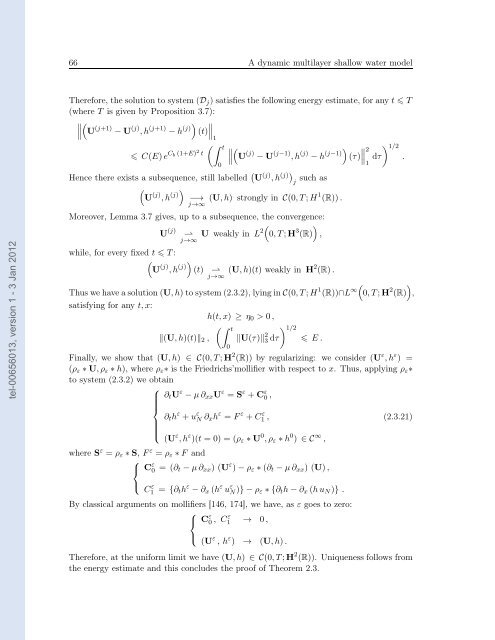Modélisation, analyse mathématique et simulations numériques de ...
Modélisation, analyse mathématique et simulations numériques de ...
Modélisation, analyse mathématique et simulations numériques de ...
You also want an ePaper? Increase the reach of your titles
YUMPU automatically turns print PDFs into web optimized ePapers that Google loves.
tel-00656013, version 1 - 3 Jan 2012<br />
66 A dynamic multilayer shallow water mo<strong>de</strong>l<br />
Therefore, the solution to system (Dj) satisfies the following energy estimate, for any t T<br />
(where T is given by Proposition 3.7):<br />
<br />
<br />
U (j+1) −U (j) ,h (j+1) −h (j)<br />
<br />
<br />
(t)<br />
C(E)e Cb (1+E) 2 t<br />
<br />
1<br />
t<br />
0<br />
<br />
<br />
<br />
U (j) −U (j−1) ,h (j) −h (j−1)<br />
Hence there exists a subsequence, still labelled U (j) ,h (j)<br />
<br />
U (j) ,h (j)<br />
j<br />
such as<br />
−→<br />
j→∞ (U,h) strongly in C(0,T;H1 (R)).<br />
Moreover, Lemma 3.7 gives, up to a subsequence, the convergence:<br />
U (j) ⇀ U weakly in L<br />
j→∞ 2<br />
0,T;H 3 <br />
(R) ,<br />
while, for every fixed t T:<br />
<br />
U (j) ,h (j)<br />
(t) ⇀<br />
j→∞ (U,h)(t) weakly in H 2 (R).<br />
<br />
<br />
(τ) 2<br />
1 dτ<br />
Thus we have a solution(U,h) to system (2.3.2), lying inC(0,T;H 1 (R))∩L ∞<br />
0,T;H 2 (R)<br />
satisfying for any t,x:<br />
h(t,x) ≥ η0 > 0,<br />
t<br />
(U,h)(t)2 , U(τ)<br />
0<br />
2 1/2<br />
3 dτ E.<br />
Finally, we show that (U,h) ∈ C(0,T;H 2 (R)) by regularizing: we consi<strong>de</strong>r (U ε ,h ε ) =<br />
(ρε ∗U,ρε ∗h), where ρε∗ is the Friedrichs’mollifier with respect to x. Thus, applying ρε∗<br />
to system (2.3.2) we obtain<br />
⎧<br />
⎪⎨<br />
⎪⎩<br />
∂tU ε −µ∂xxU ε = S ε +C ε 0 ,<br />
∂th ε +u ε N ∂xh ε = F ε +C ε 1 ,<br />
(U ε ,h ε )(t = 0) = (ρε ∗U 0 ,ρε ∗h 0 ) ∈ C ∞ ,<br />
where Sε = ρε ∗S, Fε = ρε ∗F and<br />
⎧<br />
⎨ C ε 0 = (∂t −µ∂xx) (U ε )−ρε ∗(∂t −µ∂xx) (U),<br />
⎩<br />
C ε 1 = {∂th ε −∂x(h ε u ε N)}−ρε ∗{∂th−∂x(huN)} .<br />
By classical arguments on mollifiers [146, 174], we have, as ε goes to zero:<br />
⎧<br />
⎨ → 0,<br />
⎩<br />
C ε 0 , Cε 1<br />
(U ε , h ε ) → (U,h).<br />
1/2<br />
.<br />
<br />
,<br />
(2.3.21)<br />
Therefore, at the uniform limit we have (U,h) ∈ C(0,T;H 2 (R)). Uniqueness follows from<br />
the energy estimate and this conclu<strong>de</strong>s the proof of Theorem 2.3.

















